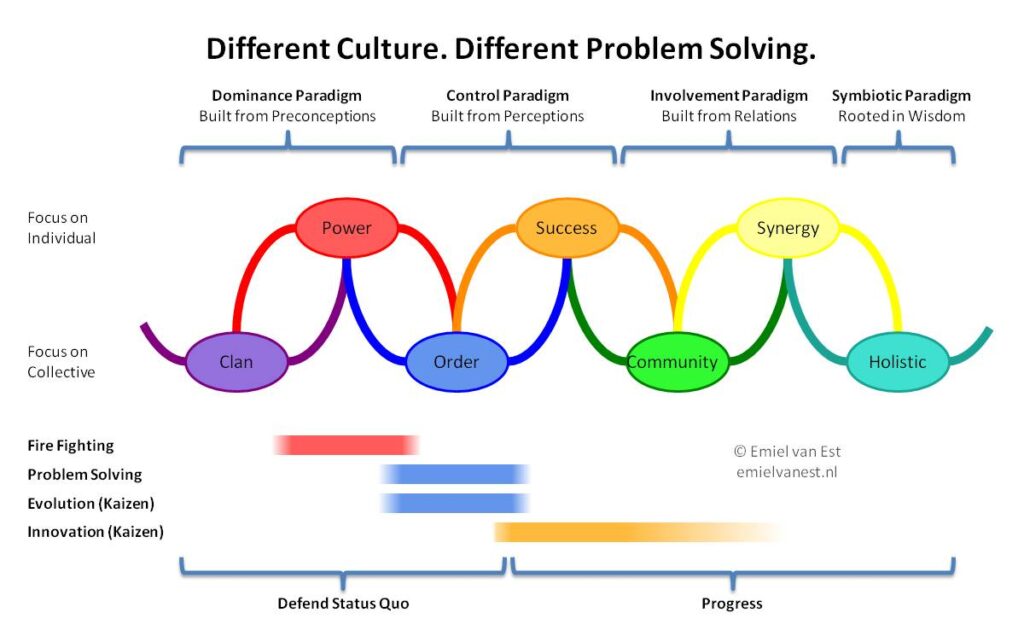The past few weeks I have been matching what have I learned about Continuous Improvement with the cultural perspectives of Spiral Dynamics. It brings all kinds of interesting insights. For example about problem solving:

Fire Fighting
A popular way to solve problems is called fire fighting. It involves emergency based action to find a short term fix for problems or the suppression of their symptoms. It is seen as a bad way of handling problems because it is largely based on preconceptions and therefore most fixes are only temporarily effective and the problems typically reoccur.
We are very good at solving problems.
Practice makes perfect…
We solve the same problems every day.
I associate fire fighting with a RED Power culture. Fire fighters are the hero’s of the organization and typically get a lot of status since they know how to save the day. Many even get promoted because of this ability.
Many fire fighters tend to resist finding and eliminating the root causes of problems, they tend to defend the status quo. They tend to defend their hero-like status.
Problem Solving
To really solve a problem, the causes of the problem need to be eliminated. In the case of a fire that might include the fuel, the oxygen or a high temperature. If we can prevent this mix of conditions to occur there will never be a fire again.
I associate problem solving with a BLUE Order culture that wants processes to perform consistently time and again. Very much in the Control Paradigm. By carefully analyzing the perceived facts, the causes for problems are identified and eliminated one by one and thus preventing emergency based actions.
There is little heroism in prevented problems.
Evolution (Kaizen)
The evolutionary kind of Kaizen is the most well known way of Kaizen and is very similar in nature to the problem solving described above so, I also associate this type of Kaizen with the BLUE Order culture that wants to perform according to a defined standard.
Standard:
Best known method for producing a product or service.
There may be times that it is not possible to work according to the set standard and there is a gap between the current performance and the standard performance. This is the Lean definition of a problem.
In the beginning it may be possible to work, for example, 90% of the time according to the standard. During 10% of the time there may be a gap. By eliminating the causes of these gaps the performance may improve to, for example, 95% of the time according to standard. So, over time the performance improves in small steps, hence the evolutionary nature of this type of Kaizen.
Innovation (Kaizen)
Many may be surprised to see innovation as Kaizen but Toyota explains Kaizen as:
Kaizen:
The Toyota Way 2001
We improve our business operations continuously, always driving for innovation and evolution.
I find it interesting that innovation is mentioned before evolution. To me, as a Toyota Kata practitioner, that makes a lot of sense. If you want to improve do you want improvement in small or big increments?
The small increments may just be too slow to stay successful in business. Step changes may be needed. Therefore I associate the innovative kind of kaizen with a ORANGE Succes culture.
In Toyota Kata terminology you try to reach a challenge by working on successive target conditions to achieve a level of performance in the (near) future that is currently not yet possible.
Target Condition:
My definition to contrast a Target Condition with a Standard
Better unknown method for producing a product or service.
Kaizen’s Balancing Act
Both the evolutionary kind of Kaizen as the innovative kind of Kaizen are very much in the Control Paradigm and build on perception.
But there is a very distinct difference between a BLUE Order culture and a ORANGE Succes culture. In the BLUE Order culture it is important to defend the status quo, to adhere to the standard. In the ORANGE Succes culture it is important to create progress, to change the standard.
To keep the standard or to change the standard. That is the question.